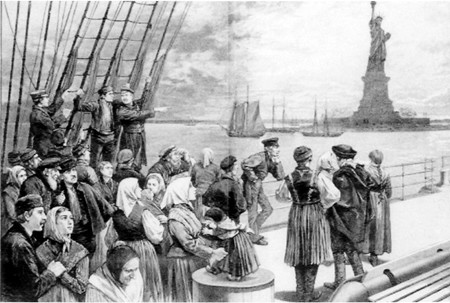|
Heading for a new
world

First sight of New York for late 19th century immigrants.
The number of immigrants from
Lincolnshire to the colonies during the 19th century was extremely high as
hundreds of people were attracted by the prospect of a new life in another
land.
In the first fifty years of the century alone, many departed from Bourne
and the surrounding villages and in February 1844, three families from
Dowsby sailed for New South Wales together with a father, mother and seven
children from the adjoining parish of Aslackby, while in June 1848, 21 people from Morton left for North America, among them 17 with the name
Taylor including father, mother, sons and daughters.
Sail rather than steam carried passengers over the seas and despite the
long voyages, Australia was a popular destination although most people
favoured North America. Shipping lines advertised berths in the local
newspapers with boats of 1,000 to 1,500 tons sailing regularly from
Liverpool and in 1845 one company offered passage to New York in 29-31
days and New Orleans in 30 days “with the most superior accommodation for
passengers”.
Other packet ships left regularly for Philadelphia, Baltimore and Boston,
and one company even had a smaller sailing ship of 200 tons leaving from
Wisbech which reduced the usual journey time by road to Liverpool for
passengers from the Bourne area.
One typical newspaper advertisement from 1845 circulating in the Bourne
area said: “Emigrants in the country can engage passage by letter stating
the port to which they intend to go, when the price of passage and all
other particulars will be stated, so that they need not be in Liverpool
until the day before the ship is to sail, and they will thereby avoid
detention and other expenses, besides securing a cheaper passage, and
having the best berths allotted to them previous to their arrival. For
further particulars apply (post-paid and including a postage stamp for a
reply) to James Beckett and Son, North End Prince’s Dock, Liverpool.”
Special stagecoaches left central points around the country to take
immigrants to the dockside at their port of departure and the journey and
the voyage was made so appealing that hundreds flocked to go, so many in
fact that questions were raised in Parliament about the loss of valuable
workers from this country.
In June 1844, Sir John Trollope, the M P for Lincolnshire, voiced the
fears of many landowners when he spoke during a debate in the House of
Commons. “Not less than 100 families comprising some of the cleverest
artisans and most skilful farmers in Lincolnshire emigrated from one spot
in the county”, he said, “and an affecting and pitiful sight it was to see
these men abandoning their homes to seek new habitations on the other side
of the Atlantic. It is a serious loss to the mother country when the best
and most industrious of her citizens leave our shores and settled in foreign
climes.”
But the flow of immigrants had become unstoppable and week after week more
men, often with their girlfriends, wives and families, chose to take the
risk. Many found wealth and happiness while others discovered that life in
the new world could be just as harsh as it was at home.

Go to:
Main Index Villages
Index
|
